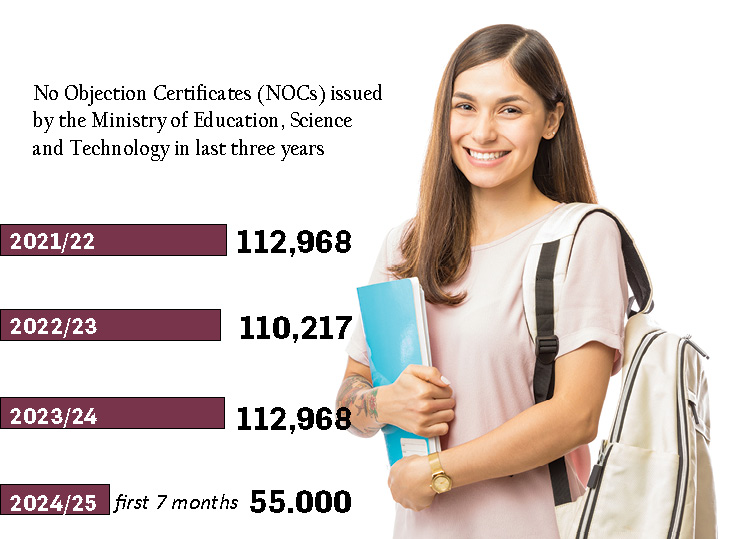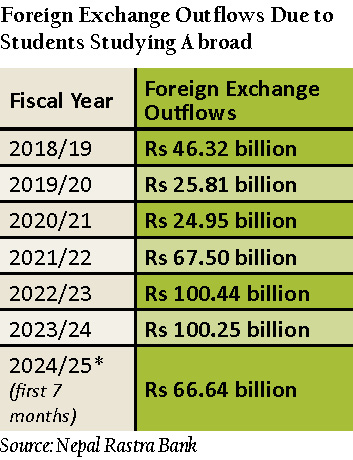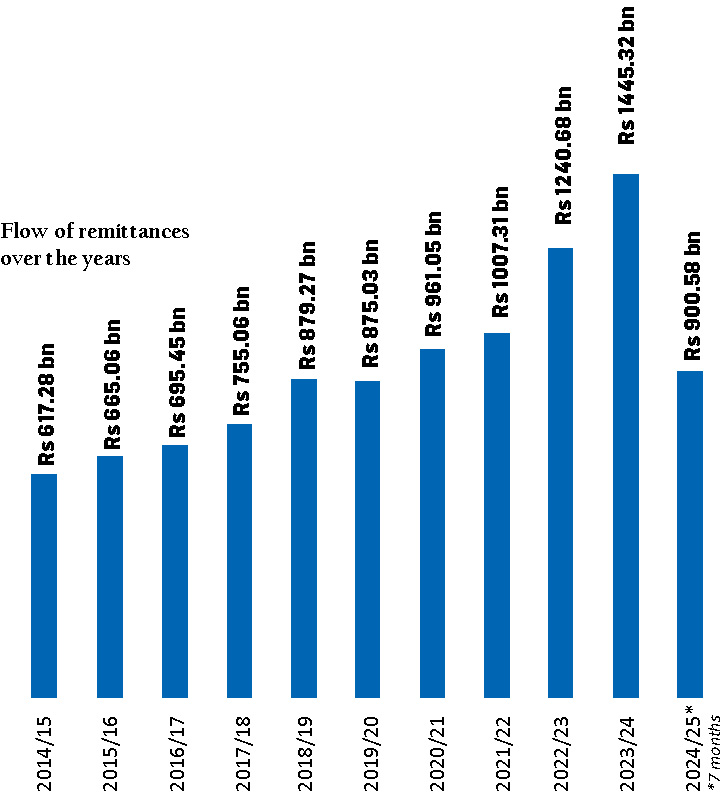 The nation has been grappling with significant challenges alongside a substantial exodus of students. This mass migration, widely considered an outflow, involves a large number of students seeking education abroad. The recent tragic suicide of Nepali student Prakriti Lamsal, a third-year B-Tech student at the Kalinga Institute of Industrial Technology (KIIT) in Odisha, India, has starkly highlighted the extent of Nepali students pursuing education even in Indian universities that specifically aim to serve tribal communities. The fact that 1,169 Nepali students are enrolled at KIIT underscores the deficiencies and ineffectiveness of Nepal’s own education system.
The nation has been grappling with significant challenges alongside a substantial exodus of students. This mass migration, widely considered an outflow, involves a large number of students seeking education abroad. The recent tragic suicide of Nepali student Prakriti Lamsal, a third-year B-Tech student at the Kalinga Institute of Industrial Technology (KIIT) in Odisha, India, has starkly highlighted the extent of Nepali students pursuing education even in Indian universities that specifically aim to serve tribal communities. The fact that 1,169 Nepali students are enrolled at KIIT underscores the deficiencies and ineffectiveness of Nepal’s own education system.
Nepali students are increasingly choosing to immigrate to various countries across the globe for their studies. Dr. Swarnim Wagle, a Parliamentarian and former Vice Chairperson of the National Planning Commission, has pointed out that the office responsible for issuing No Objection Certificates (NOCs) to students aspiring to study overseas is overwhelmed, processing approximately 115,000 NOCs annually.
“It’s regrettable that students feel compelled to seek better academic opportunities elsewhere because our policymakers have utterly failed to improve the country’s education system to a level where students can have confidence,” he stated. “Despite this lack of trust in our higher education and the opportunities it should provide for talented individuals, the government has turned a deaf ear and is simply witnessing the country’s loss.”
In this context, Nepal faces a critical two-pronged challenge: the drain of its talented students and the outflow of its foreign currency reserves.
 Talent drain is alarming
Talent drain is alarming
A total of 3.4 lakhs students obtained NOCs in the last four years and 6,239,148 in the last one decade. The outflow of students for a small Himalayan nation with a population of just 29 million is not only relatively high, but alarming.
The long-term consequences of this talent drain are set to be complex and far-reaching. However, in the immediate future, it’s already taking a toll on our foreign exchange reserves. The amount of foreign currency that students take with them to their overseas study destinations is nearly the same as what we spend on importing petroleum products – a major drain on the country’s finances.
Nepal has been making considerable efforts to reduce its reliance on imported petroleum by encouraging the generation and use of hydroelectricity, promoting electric vehicles, and supporting clean cooking methods, among other initiatives. Yet, the seriousness and weight of the challenges presented by the student exodus have been underestimated, according to Professor Dr. Kusum Shakya, former Dean of the Faculty of Humanities and Social Sciences at Tribhuvan University.
“There’s a feeling among students that if they’re going to have to move abroad for job prospects anyway, they might as well pursue their higher education in foreign universities for better opportunities,” she explained. “Opportunities are the driving force behind this significant emigration.”
Tradeoff between remittances and talent outflow
Experts suggest that the outflow of students has, in some ways, helped to diversify the sources of remittances. For many students, even though they initially go abroad for higher education, a primary goal is to earn money to support their families back home.
“If our policymakers consider restricting student emigration solely based on the amount of foreign currency they take out, it would be a dangerous move,” commented Nara Bahadur Thapa, an economist and former Executive Director of Nepal Rastra Bank. “Prioritising improvements in higher education and creating opportunities should be the government’s focus, but forcibly curbing the outflow of students shouldn’t be seen as a desirable option by anyone who understands the trade-offs,” he added.
Thapa further noted that Nepal has seen record high foreign exchange reserves in recent years, coupled with a surge in remittance inflows and a stagnation of imports. “The students who are pursuing higher education are valuable assets for the country,” he stated. “It’s the state’s responsibility to generate opportunities and foster an environment that encourages them to return.”
 However, students who pursue higher education abroad rarely come back due to the absence of compelling opportunities within Nepal, significantly reducing the country’s prospects of experiencing a ‘brain gain’ unless attractive opportunities are created to draw them back.
However, students who pursue higher education abroad rarely come back due to the absence of compelling opportunities within Nepal, significantly reducing the country’s prospects of experiencing a ‘brain gain’ unless attractive opportunities are created to draw them back.
According to Thapa, with the nation’s foreign currency reserves being robust for the past several years, it’s the government’s duty to provide facilities to its citizens, especially considering their contribution to these reserves. He stated, “Preventing, curbing and controlling are harsh and inhumane ways of addressing these issues, which cannot be considered ethical for authorities in a democratic system.”
As per Nepal Rastra Bank, Nepal’s foreign exchange reserves stood at US$17.05 billion until mid-February.
Preference of students
A significant number of students obtaining No Objection Certificates favoured Australia as their destination for higher education, with Japan being the second most popular choice, followed by the United Kingdom, Canada, the United States of America, South Korea and India. Neighbouring India ranks as the seventh most preferred country for Nepali students seeking higher education.
According to the NOC section of the Ministry of Education, Science and Technology, students have obtained NOCs for 66 countries, including Eastern European nations that are also popular among Nepali migrant workers, such as Poland, Romania and Croatia. Additionally, Cyprus, Montenegro, Azerbaijan, Lithuania and Slovenia are also among the preferred destinations for Nepali students pursuing higher studies. An analysis of the trend of student emigration, based on the No Objection Certificates issued by the Ministry of Education, Science and Technology, strongly indicates that job prospects are a major driving force for many students.
In Nepal, numerous academic institutions operating under the affiliation of international universities have been offering various programmes prescribed by these international universities in an attempt to attract students. However, their impact is largely minimal when considering the overall outflow of students seeking education abroad.
Ideally, colleges affiliated with international universities should nurture world-class talent. Nevertheless, the limited opportunities available within the country often compel many graduates to look for employment overseas. Therefore, student emigration is not solely motivated by academic aspirations but also by a strong desire for career progression.



